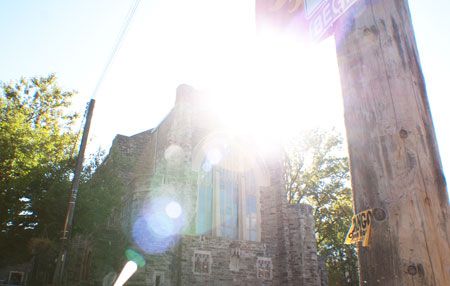A server water shortage led a city in Mexico to employ school children to take charge in support of water preservation. These students are changing attitudes and behaviours of their peers and adults.
Matamoros, a northeastern city in Mexico minutes away from Texas, is the last largest city that uses water from Rio Grande, the "Big River" that originates in Colorado. When the river dried up in July 2000, the city's water department resorted to enlisting thousands of schoolchildren as "water detectives"—or "los detectives del agua" in Spanish, to be educated about water preservation, to search and report water leakages and wasteful behaviours around the city, and to educate others about the importance of proper water usage. In 2004, Matamoros consumed 18 per cent less water than in 2003, a result attributed to the tireless water detectives.
"If a 'green culture' is not there," said executive director of Green venture Pete Wobschall after giving the Matamoros' success story as an example during a presentation of an energy audit on Oct. 10, "You are really limiting what technology can do for you."
Greening Sacred Spaces, an imitative to educate faith communities about ecological issues and to help them create sustainable worship spaces, brought on Green Venture, a community-based non-profit organization committed to sustainability. Green Venture was implemented to perform an energy audit on Melrose United Church, an 80-years-old church in downtown Hamilton.
While most people do not have the luxury of a historical church that needs an energy audit, most people do live in homes that could benefit from energy audits.
"We've done an energy audit on a house that is less than two years old." Wobschall thinks that most Canadians do not build with the environment in mind.
"We design houses really poorly," Wobschall pointed out. In his opinion, taking advantages of free and readily available energy sources like the sun helps to keep tabs on energy bills. For instance, small or no window should be put on the northwest side of a house because "the sun is not there." Meanwhile, bigger windows should be placed on the southeast to take advantage of the free source of light and heat. Moreover, simple things like adding an awning could prevent the summer sun from overheating the space while allowing the winter sun to warm it up.
In Canada, the most common type of space heating system is a forced-air system. It delivers heated air through ductworks and exchanges fresh air by drawing new air through vents. The constant exchange of air means the system does extra work to heat the outdoors.
“Some countries don’t even use that technology anymore—it’s so expensive to blow air around and it’s so inefficient,” said Wobschall. European countries, particularly United Kingdom have turned to alternatives like under-floor heating where warm water pipes are installed within the floor to radiate heat.
Wobschall also thinks we should care more about our “future generations than dollars.”
"What we do in subdivisions is we build beautiful houses but don’t care about anything else," said Wobschall. "We just want to plot as many houses as we can to make as much money as we can."
He suggested that people need to have a holistic view of buildings. The best eco-friendly approach is not retrofitting or replacing equipments, but "building homes correctly."
Dave Braden, Hamilton's former city councilor and a home builder, built an off-the-grid house which does not rely on municipal source of energy, and claims that it "can be heated with a hair dryer come with its own electricity supply."
"[Braden] built the house, wrapped it, and built another house around it,” Wobshcall gave insight into the autonomous house; "it sounds like a lot, but it only cost $10,000 to build the other house, and it reduces the energy consumption by 98 per cent."
For existing buildings that are not performing efficiently energy-wise, Wobschall suggested that air sealing usually gets "the biggest bang for the buck." He once advised a client who was planning to spend $13,000 on new windows and doors to invest $3000 in air sealing instead.
According to Green Venture’s website, a poorly insulated and/or poorly air-sealed home could lose up to 30% of the heat. The temperature difference between indoor and outdoor causes the air to leak through punctures in floors, walls, and ceilings. Windows and doors are the obvious ones, small openings like recessed lights, vents, attic access, and switches also contribute to heat and energy loss.
The good news is air sealing is easy to do. Weather-stripping and caulking are perfect home do-it-yourself projects with tangible results. Tightening up leakages could save up to 15% of a heating bill, according to Union Gas.
In Melrose Church's case, it requires a more costly solution. Green Venture made an estimate cost of $162,000 to improve its energy performance, including an upgraded broiler, better ventilation control, overall air sealing and more. All of these will save the Church close to $17,000 a year, which equals to a 9.6 years payback.
Dollar figures like these scares people away, Wobschall pointed out. Energy audits which cost hundreds for houses and thousands for buildings like Melrose stop people from greening the built environment. For faith groups, initiatives like Greening Sacred Spaces brings subsidy to make it more affordable. For home owners, there is a variety of resources available from Federal and provincial government, as well as private sectors. Each of them offers a wide range of incentives to those who upgrade or retrofit their houses to using eco-friendly systems. As a starter, home owners could take a look into The Home Energy Saving Program (HESP), provided by Ontario Ministry of Energy and Infrastructure, which offers rebates for energy audits and retrofits.
Greening technology is only part of the solution to sustainability. Leaving an energy-efficient light on 24/7 is not going to help the environment, or your energy bill.
